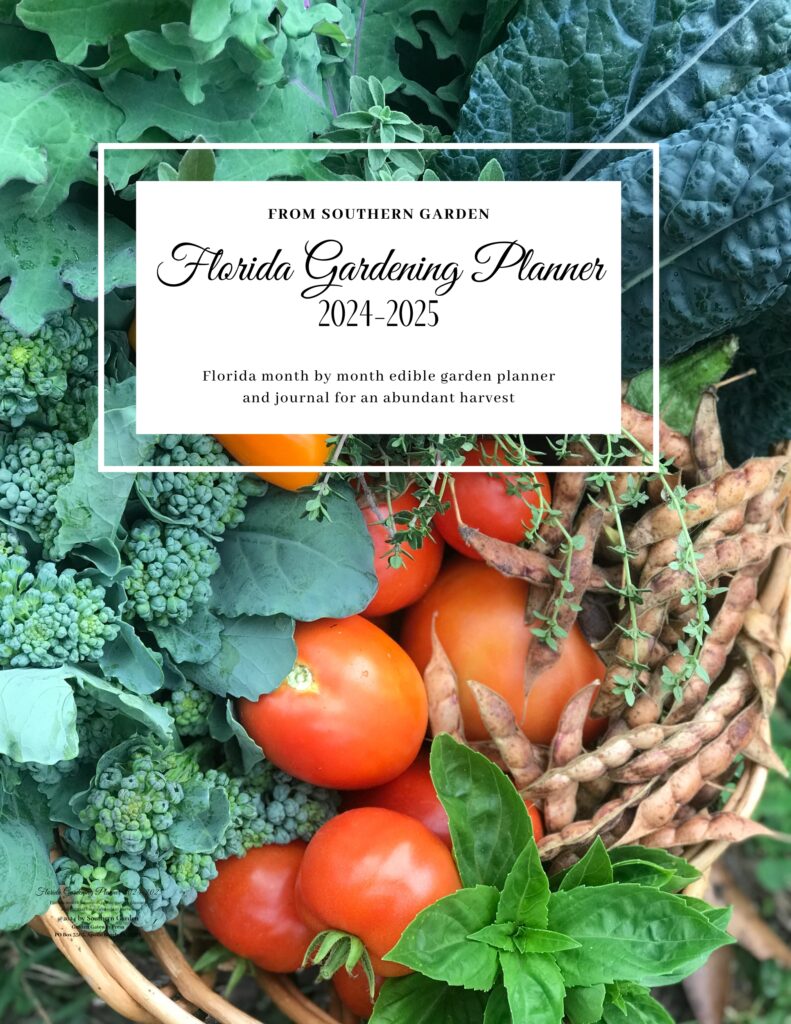Growing Texas Bluebonnets can add diversity and vivid color to any Southern region garden. They’re scientifically known as Lupinus texensis and are iconic wildflowers native to the southern United States, particularly Texas. These beloved plants belong to the Fabaceae family, commonly known as the legume or pea family.
Texas Bluebonnets thrive in USDA zones 3 through 9, although they are best suited for zones 7 through 9. They are especially well-adapted to the arid and temperate climates of their native regions, including prairies, roadsides, and open fields.
Texas Bluebonnets are annual plants, completing their lifecycle within one growing season. However, they readily self-seed, ensuring their return each year in favorable conditions.
Their growing season typically begins in the fall, with germination and early growth occurring during cooler months, followed by a spectacular bloom in late winter through early spring, usually from March to May.
Texas Bluebonnet Flowers
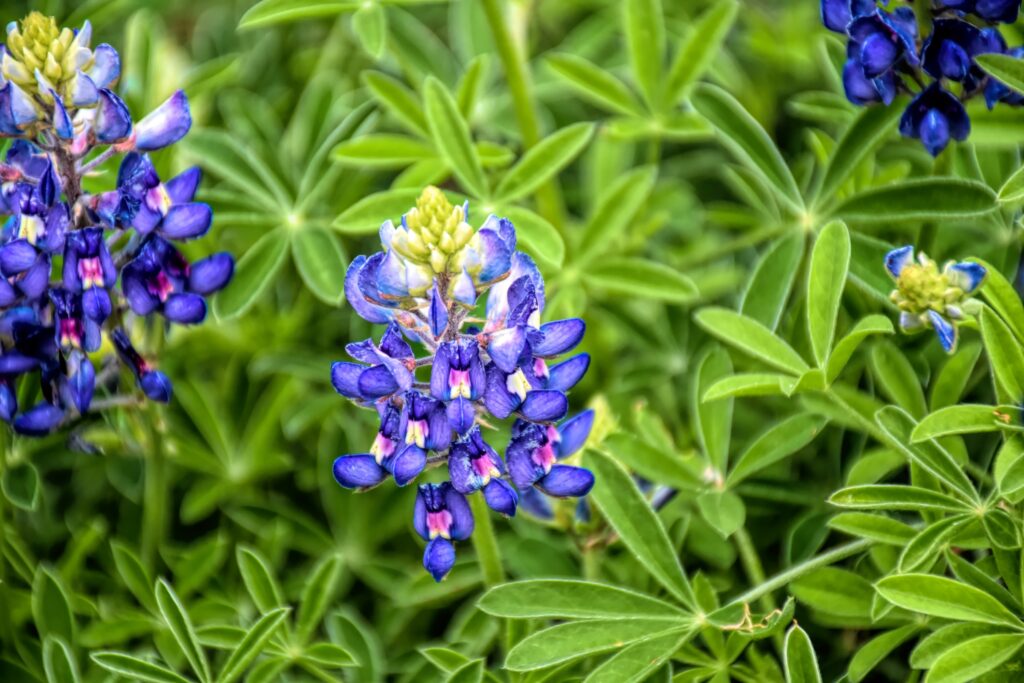
The flowers of the Texas Bluebonnet are strikingly beautiful, with shades of deep blue accented by a white or sometimes light pink “banner spot” at the top of each blossom. Individual flowers are pea-like in structure and form dense, cone-shaped clusters atop upright stems.
Each flower measures approximately 1 inch in size, while the entire flowering spike can reach 6 to 10 inches in height. The plants themselves typically grow to a height of 12 to 24 inches and spread about 12 to 18 inches wide, creating a compact yet eye-catching display.
Texas Bluebonnets are often planted in wildflower meadows, cottage gardens, or as a naturalizing groundcover. They are also a favorite for roadside beautification projects due to their low maintenance needs and stunning mass effect when planted in large swaths.
Whether used in cultivated garden beds or allowed to naturalize in open spaces, these flowers add a quintessentially Texan charm to any landscape.
Texas Bluebonnets Benefit to Wildlife
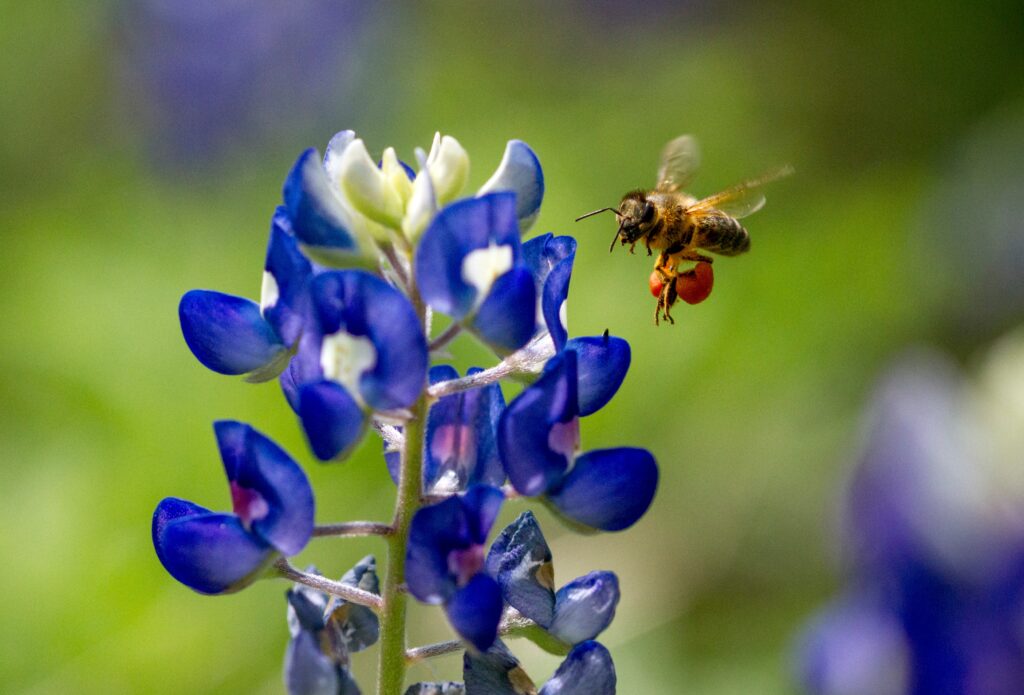
Texas Bluebonnets leave behind seeds that provide an important resource for wildlife. In the cooler months, the seeds are a food source for various birds and small mammals.
Northern Bobwhite Quail eat the seeds during the winter months. Songbirds (like sparrows and finches) forage on the seeds. And Cottontail Rabbits may nibble on the foliage in early spring.
Pollinators and other insects visit the flowers during the blooming period for nectar. Honeybees and bumblebees enjoy their nectar. Monarchs, Painted Lady, Common Buckeye, and Skipper Butterflies are also drawn to the flowers. They also attract hoverflies and moths.
Additionally, the plants contribute to the soil’s health by fixing nitrogen, enriching the soil for other plants in the following growing season.
When to Plant Texas Bluebonnets

Plant Texas Bluebonnet seeds at the correct time for successful growth and bloom. These iconic wildflowers thrive in specific conditions that vary depending on your USDA hardiness zone. Timing your planting—whether indoors or directly in the garden—ensures robust plants and abundant flowers.
Zones 3–5:
In zones 3–5, start seeds indoors 8–10 weeks before the last expected frost date. This typically falls between mid-January and early March. Use a seed-starting mix and containers to give the seeds a head start.
You can sow seeds outdoors as soon as the soil has warmed up in spring, around late April to early May. Texas Bluebonnets prefer well-draining soil and full sun.
Zones 6–8:
These zones offer a longer growing season, which allows for more flexibility in planting times. Start seeds indoors 6–8 weeks before the last spring frost. For most areas in this range, aim for mid-February to early March.
For direct sowing, fall is ideal in these zones to mimic the natural cycle of the wildflowers. Plant seeds outdoors in late September to early November. This gives seeds time to germinate and establish roots before the winter dormancy.
Zones 9–12:
In warmer zones, most gardeners plant and start growing Texas Bluebonnets in fall. You normally will not need to start seeds indoors.
For best results, sow seeds directly outdoors from late September to November. Fall planting allows seeds to germinate during the cooler winter months and bloom in early spring.
Proper timing ensures that your growing Texas Bluebonnets will establish well and reward you with vibrant blooms.
Preparing Texas Bluebonnet Seeds for Planting
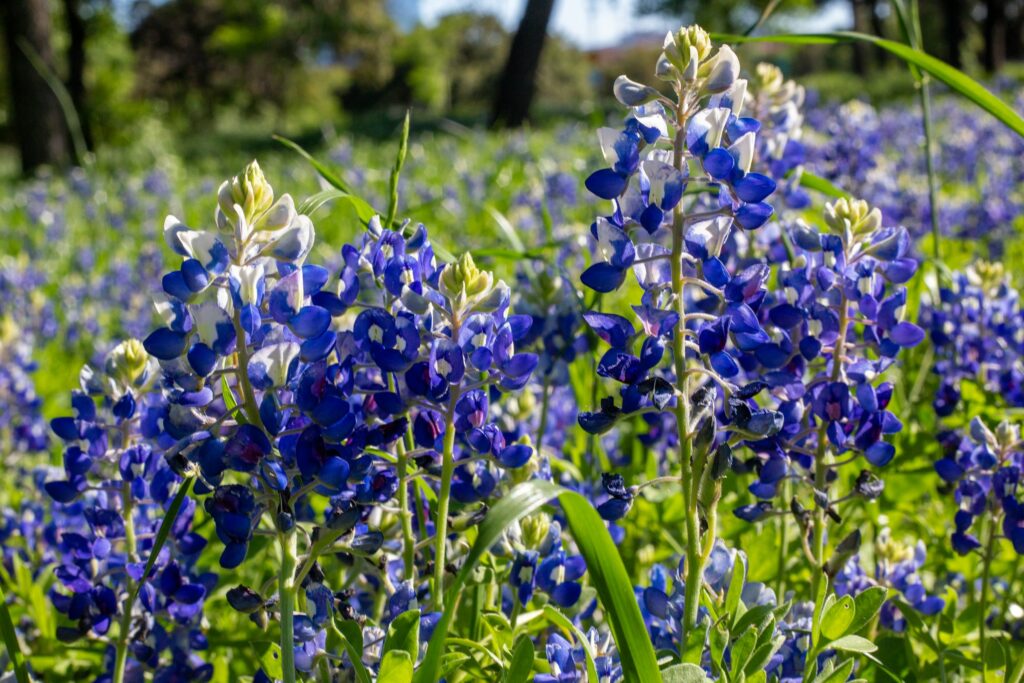
Texas Bluebonnet seeds do not need cold stratification. Instead, the key to successful germination lies in addressing their tough outer coating.
Texas Bluebonnet seeds benefit from scarification, which involves weakening the seed coat to allow moisture to penetrate. Both nicking and soaking are effective methods.
How to Prepare Texas Bluebonnet Seeds
Use a small file, nail clipper, or fine sandpaper to gently nick the outer seed coat. Focus on one side of the seed, ensuring you do not damage the interior. Stop as soon as the lighter-colored interior becomes visible.
After nicking, place the seeds in a bowl of warm water. Allow them to soak for 12–24 hours. Remove any floating seeds, as these are likely non-viable. After soaking, the seeds should appear slightly swollen and are ready to be planted.
Direct Sowing Texas Bluebonnet Seeds
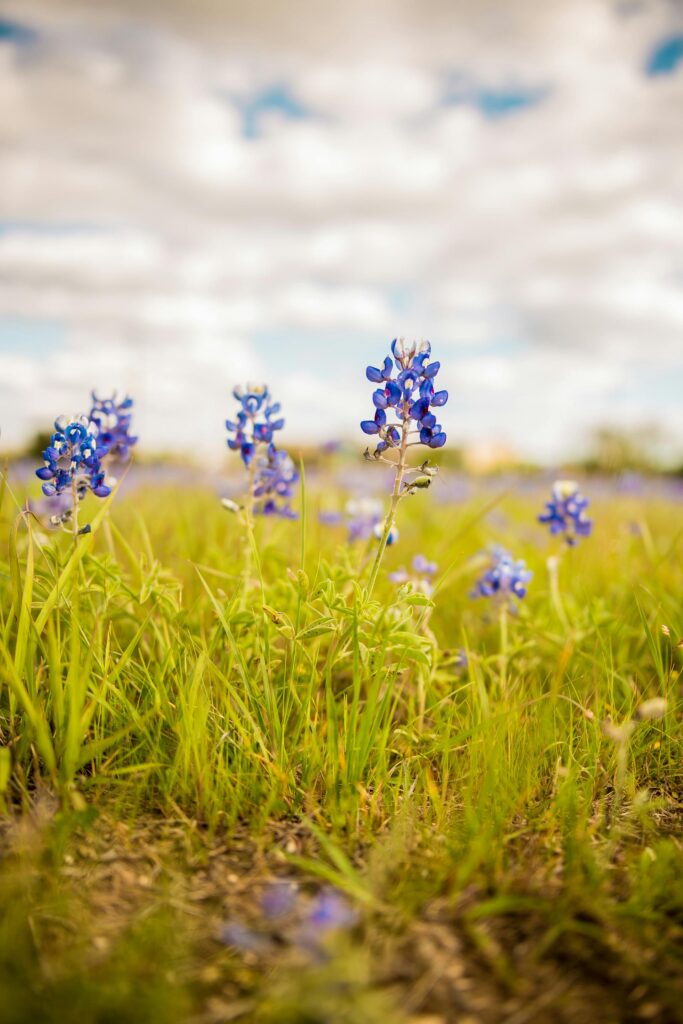
Direct sowing Texas Bluebonnet seeds is one of the simplest and most effective methods to grow these iconic flowers, as they thrive when planted directly into their natural environment. By sowing the seeds in the fall, you mimic the natural cycle of wildflowers, allowing them to establish strong roots during the cooler months and bloom in the spring. Here’s a step-by-step guide to ensure success:
Depth to Plant
Scatter the seeds on the soil surface and lightly press them into the soil. Do not bury them deeply; they should remain close to the surface, as Texas Bluebonnet seeds require light to germinate. A thin layer of soil or compost, no more than 1/8 inch thick, can be added for protection. Tamp them into the soil firmly to increase contact with the soil.
Moisture Requirement for Seeds
Keep the soil consistently moist after planting but avoid overwatering. Light watering is necessary until the seeds germinate and the seedlings are established. Rainfall during the fall and winter months typically provides adequate moisture in most regions.
Optimal Temperature for Germination
The seeds germinate best in cool soil temperatures, between 55°F and 70°F. Planting in the fall takes advantage of the natural cooling of the soil to improve root development.
Light Requirements for Germination
Texas Bluebonnet seeds require exposure to light to germinate effectively. Avoid planting them too deeply or covering them with dense mulch that blocks sunlight.
Time to Germination
Germination typically occurs within 10–14 days, though cooler temperatures may slightly extend this period.
Starting Texas Bluebonnet Seeds Indoors
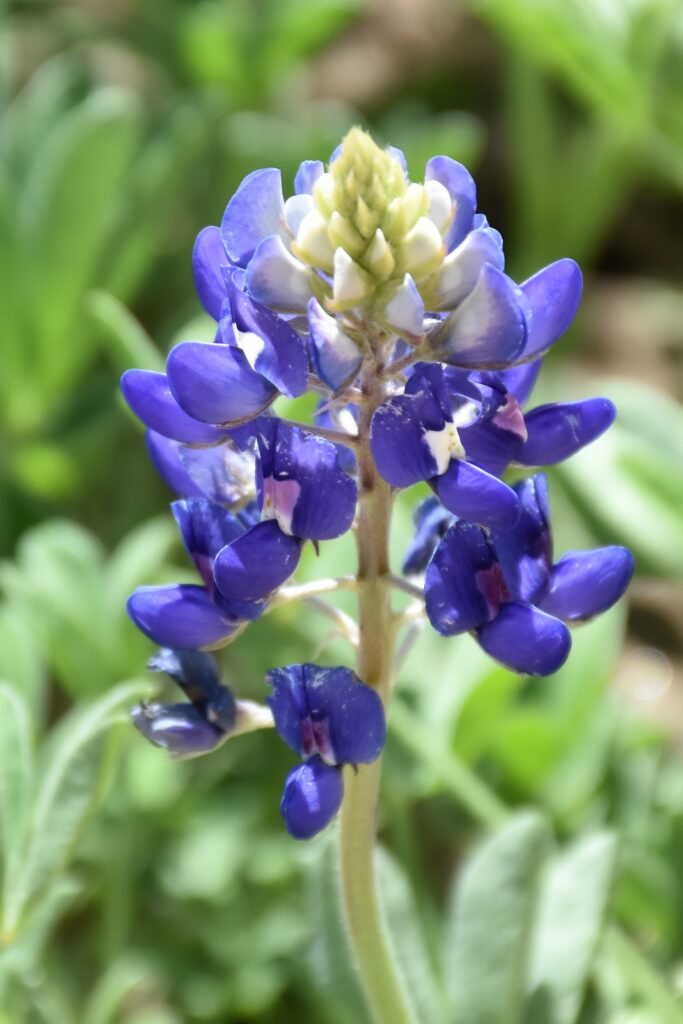
Growing Texas Bluebonnets is also possible indoors, particularly for gardeners in colder climates or those who want to give their plants a head tart before moving them outdoors.
The Right Seed Starting Mix
Texas Bluebonnets prefer well-draining soil. A good seed starting mix is light and airy, providing adequate drainage to prevent waterlogged conditions.
You can purchase a pre-made seed-starting mix or create your own by combining two parts peat moss, one part perlite, and one part vermiculite. This mix will ensure proper drainage and aeration for healthy root development.
Choose Seed Starting Containers
Use shallow containers such as cell trays or soil blocks, ensuring they are at least 2–3 inches deep.
Containers should have drainage holes to prevent water from collecting at the bottom, which could lead to seed rot.
Biodegradable seed starting pots are an excellent option for starting Bluebonnets, as it allows for easier transplanting later with less stress to the plant.
Depth to Plant
Plant the Texas Bluebonnet seeds about 1/8 inch deep. These seeds require light for germination, so ensure they are just lightly pressed into the soil, not buried deeply.
Moisture Requirement for Growing Texas Bluebonnets
Keep the soil consistently moist, but not soggy. Mist the surface of the soil or use a gentle watering can to maintain the moisture level. Avoid overwatering, which can lead to mold or seed rot.
Optimal Temperature for Germination
Texas Bluebonnet seeds germinate best at temperatures between 65°F and 70°F. Keep the containers in a warm, but not hot, environment.
Light Requirements for Germination
Bluebonnet seeds require light for germination, so ensure they are exposed to a bright location.
Place them in a sunny windowsill or under grow lights. Grow lights should be positioned about 2–4 inches above the seeds and run for about 12–16 hours a day to ensure the seedlings get enough light to grow strong.
Time to Germination
Seeds should begin to germinate within 10–14 days.
Keep a close watch on the soil moisture and light conditions. Once germination begins, reduce the watering and ensure the seedlings have adequate light to develop strong roots.
When to Transplant Growing Texas Bluebonnets Outdoors

Knowing when to transplant your Texas Bluebonnets into the garden will ensure that they thrive. These plants are relatively hardy but will perform best when they are moved outdoors at the right time. Here’s how to determine when your seedlings are ready to be planted in the garden:
- Texas Bluebonnets are relatively cold-tolerant but should not be exposed to frost once they are ready to be planted outdoors. Wait until the last frost date in your area has passed and the outdoor temperature is consistently between 60°F and 75°F.
- Your Bluebonnet seedlings should have at least 2-3 sets of leaves and be strong enough to withstand outdoor conditions. The plants should be about 4-6 inches tall before transplanting.
- Ensure the garden soil is well-drained and that the weather is not too wet or soggy, as overly moist soil can harm your seedlings.
Once you’re sure that the seedlings are hardy and the conditions are right, it’s time to prepare for hardening off.
Hardening Off Your Growing Texas Bluebonnet Plants
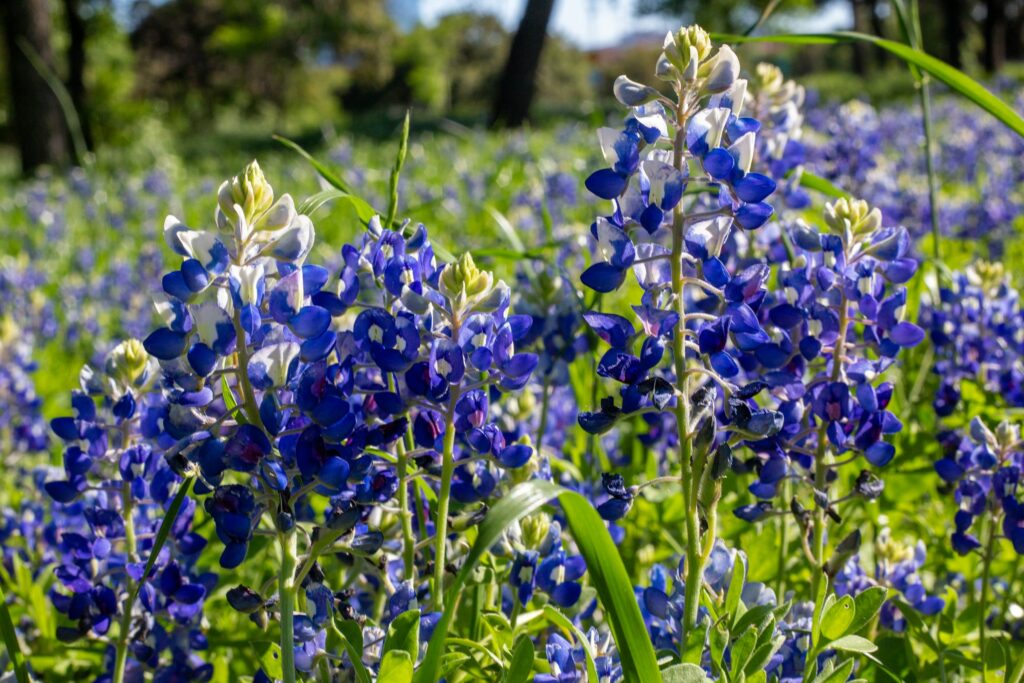
Hardening off will help them adjust to the outdoor environment gradually. Sudden exposure to full sunlight and fluctuating temperatures can shock young plants and stunt their growth.
Begin hardening off your seedlings 7–10 days before planting them out.
Place the seedlings outside in a shady spot for 1–2 hours on the first day. Gradually increase the exposure time by 1–2 hours each day.
By the third day, move the seedlings into partial sunlight for a few hours.
Gradually increase their exposure to direct sunlight each day, so they are fully acclimated by the end of the hardening-off period.
Avoid hardening off on windy or rainy days, as the seedlings may not be able to tolerate these harsh conditions. Also, protect your seedlings from any unexpected cold weather during the hardening process.
Watch for signs of stress, like wilting or yellowing leaves. If this occurs, provide some shade or shelter for the seedlings and shorten the exposure time for a day or two.
If the nights are still cold, bring your seedlings back inside at night or provide protection for them (such as placing them under a cold frame or using row covers).
After 7–10 days of gradual exposure, the Bluebonnets will be ready to be planted directly into the garden. Ensure the weather is mild and no frost is expected for the next several weeks. Plant them into their final locations, spacing them as recommended.
Preparing Garden Beds for Growing Texas Bluebonnets
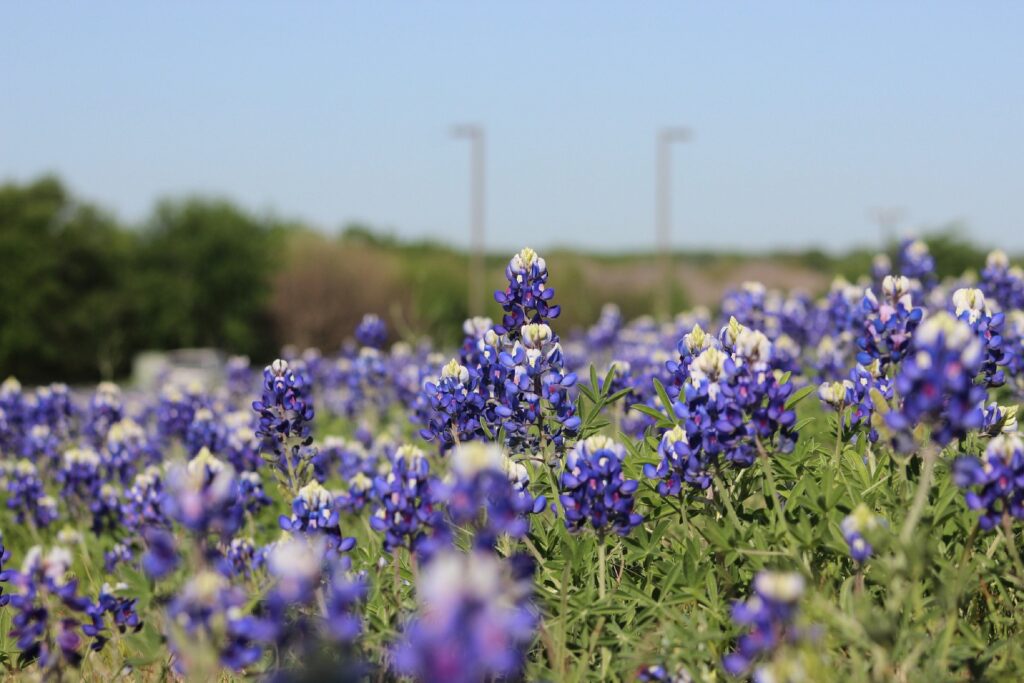
Texas Bluebonnets (Lupinus texensis) are beautiful, hardy wildflowers that thrive in well-prepared garden beds. Proper bed preparation ensures your plants receive the best environment for growth, resulting in vibrant blooms. Follow these step-by-step instructions to prepare your garden bed for planting Texas Bluebonnets:
Choosing a Location
Texas Bluebonnets need a location that provides them with the right conditions for healthy growth. Choose a spot in your garden that has the following:
Texas Bluebonnets require full sun to thrive. Select a location that receives at least 6–8 hours of direct sunlight per day.
Ensure the area has well-draining soil to prevent waterlogging, which can lead to root rot. Avoid standing water.
Soil Type Preferences
Texas Bluebonnets grow best in soil that is slightly acidic to neutral. They prefer a pH between 6.0 and 7.0, which is slightly acidic to neutral. You can test your soil’s pH with a simple soil test kit and amend it if necessary.
The plants prefer sandy, well-drained soils but will grow in a variety of soil types. If your soil is heavy clay, consider improving drainage by adding organic matter like compost.
Mix in compost or well-rotted manure to improve soil structure, enhance drainage, and provide nutrients for healthy growth.
Transplanting Your Texas Bluebonnets
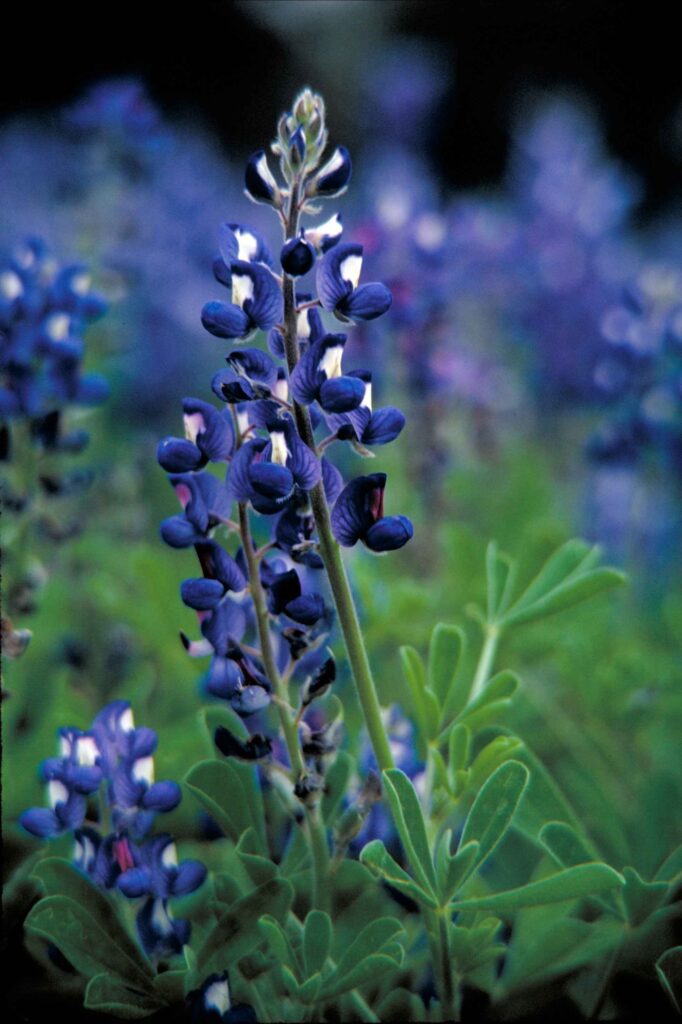
Texas Bluebonnets should be planted at the same level as they were grown in their starter pots or trays. The top of the root ball should be level with the soil surface. Avoid planting too deeply, as this can cause the stem to rot.
To ensure good air circulation and allow the Texas Bluebonnets to grow to their full potential, space them about 12–18 inches apart to allow for their mature size.
Once the plants are in the ground, apply a thin layer of organic mulch (such as shredded bark, straw, or compost) around the base of each plant, leaving some space around the stem to prevent rot. This will help retain moisture and suppress weed growth.
After transplanting your Texas Bluebonnets, give them a thorough watering to help settle the soil around the roots. Afterward, water regularly, but avoid overwatering. Texas Bluebonnets like moist soil, but it should not be soggy.
Texas Bluebonnets Care

Texas Bluebonnets are relatively low-maintenance once established but will benefit from proper attention in terms of watering, feeding, weeding, and pest control. Below is a detailed guide on how to care for your Texas Bluebonnet plants:
Watering
Once Texas Bluebonnets are established, they can tolerate drought conditions. Water only during prolonged dry periods. They prefer well-draining soil and don’t thrive in overly wet conditions.
Feeding
Texas Bluebonnets thrive in relatively poor soil conditions, so they don’t need heavy fertilizing. Over-fertilizing can lead to lush foliage at the expense of blooms.
Bluebonnets are nitrogen-fixing plants, meaning they have the ability to extract nitrogen from the air, so they typically don’t need additional nitrogen. However, if soil quality is poor, a light application of compost in early spring before growth starts can help condition the soil.
Weeding
Texas Bluebonnets are fairly good at competing with weeds once they are established, but young plants may need help to prevent competition from weeds. Carefully remove them by hand if desired.
Pest Control
While Texas Bluebonnets are generally pest-resistant, there are a few insects that might target them. However, they are not particularly prone to severe pest issues.
Aphids can sometimes infest Bluebonnets, particularly during the early growth stages. You can control them by spraying the plants with a strong stream of water or using insecticidal soap.
Cutworms may chew on young seedlings. Prevent damage by using an organic insecticide.
Encourage beneficial insects, such as ladybugs and lacewings, which help control aphid populations. Avoid using broad-spectrum chemical pesticides, as they may harm these helpful insects.
Tips and Tricks for Growing Texas Bluebonnets
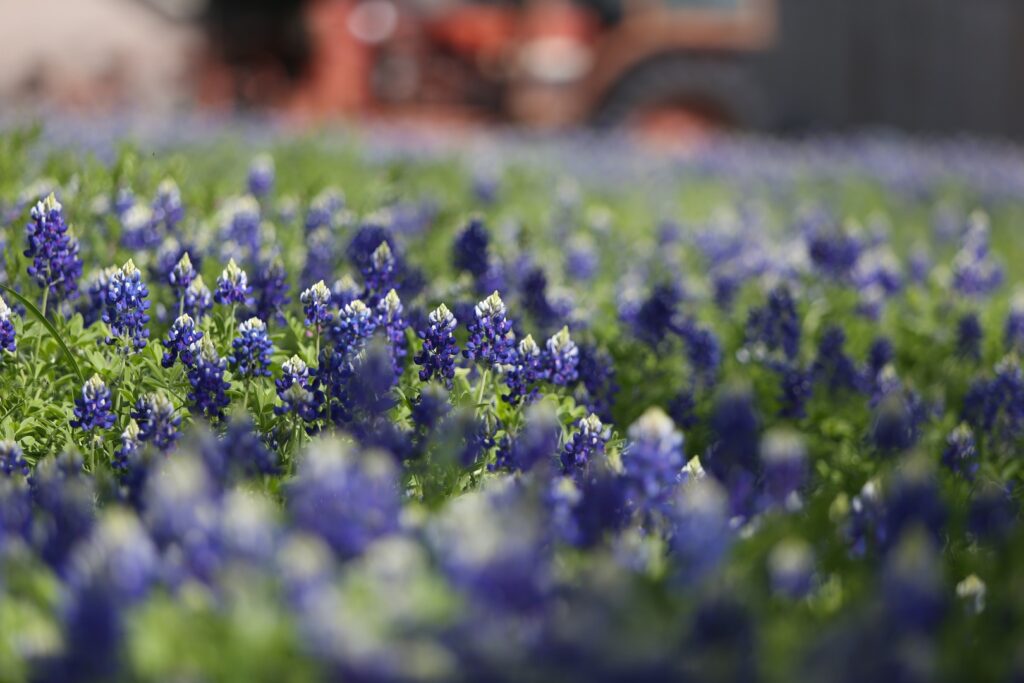
Texas Bluebonnets are relatively easy to grow, but there are a few tricks that can help you maximize their beauty and success in your garden. Here are some tips and answers to common questions about growing these iconic wildflowers:
Encourage Self-Seeding
Texas Bluebonnets are excellent self-seeders. If you want them to return year after year, allow the plants to naturally drop their seeds at the end of the growing season. Once the flowers fade, leave the seed pods in place until they dry out and crack open. This will let the seeds fall back into the soil, ensuring the next generation of Bluebonnets.
Avoid Over-Fertilizing
Texas Bluebonnets thrive in poor to moderately fertile soil. Over-fertilizing can lead to excessive foliage growth at the expense of flowers. If your soil is very fertile, you might not need to fertilize at all.
Are You Growing Texas Bluebonnets for Cut Flowers?
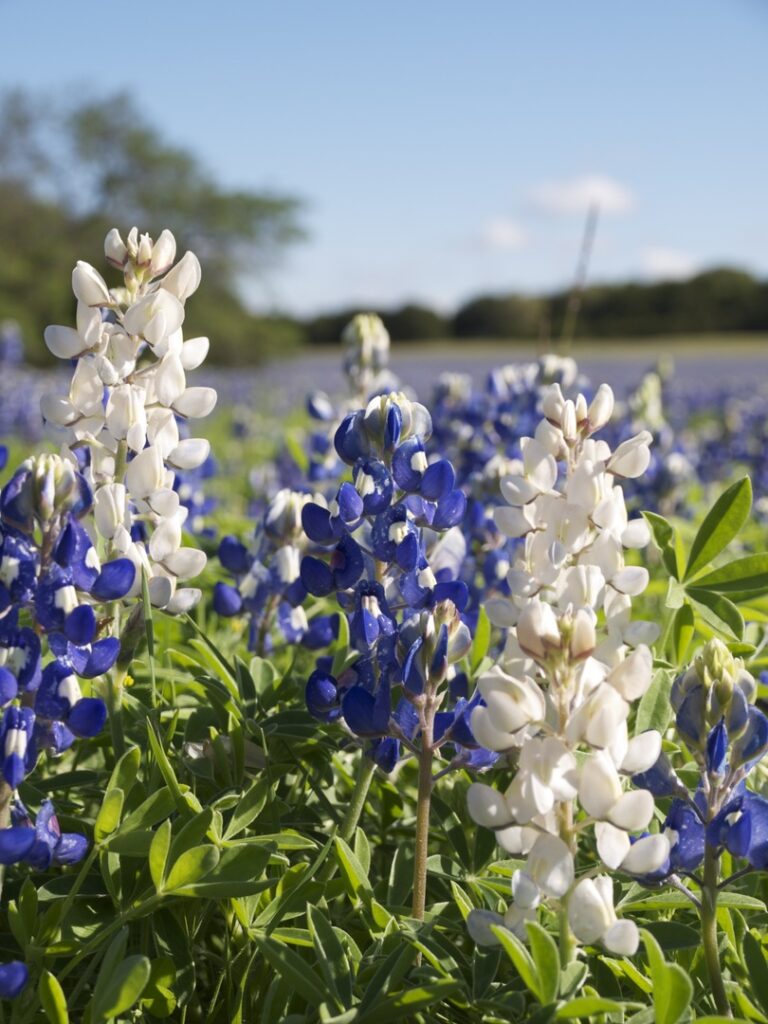
Texas Bluebonnets can make stunning additions to bouquets with their vibrant blue color and unique shape. To harvest them, it’s important to choose flowers that are fully open but not yet starting to fade.
Use sharp scissors or pruning shears to cut the flower stems at an angle, ensuring you leave some foliage behind for the plant to continue growing.
Harvesting early in the morning when the flowers are well-hydrated will help them last longer once cut. Be sure to handle the stems gently, as they can be somewhat fragile.
Once cut, place the Bluebonnets immediately into a vase of water.
To extend their vase life, which typically lasts about 5-7 days, it’s helpful to change the water every couple of days and trim the stems again at an angle to improve water absorption.
Bluebonnets tend to look best in arrangements that highlight their striking color and shape, such as simple wildflower bouquets or mixed arrangements with other early-spring blooms like daisies or primroses.
For creating bouquets, consider pairing Texas Bluebonnets with other native flowers, such as Indian paintbrush or Black-Eyed Susans, for a truly Texan feel.
Alternatively, they can be combined with softer, complementary blooms like lavender or white daisies to allow their bold blue hue to really shine. Just remember to avoid overcrowding the arrangement to allow each flower to be seen and appreciated.
Texas Bluebonnet Bloom Season and Lifespan
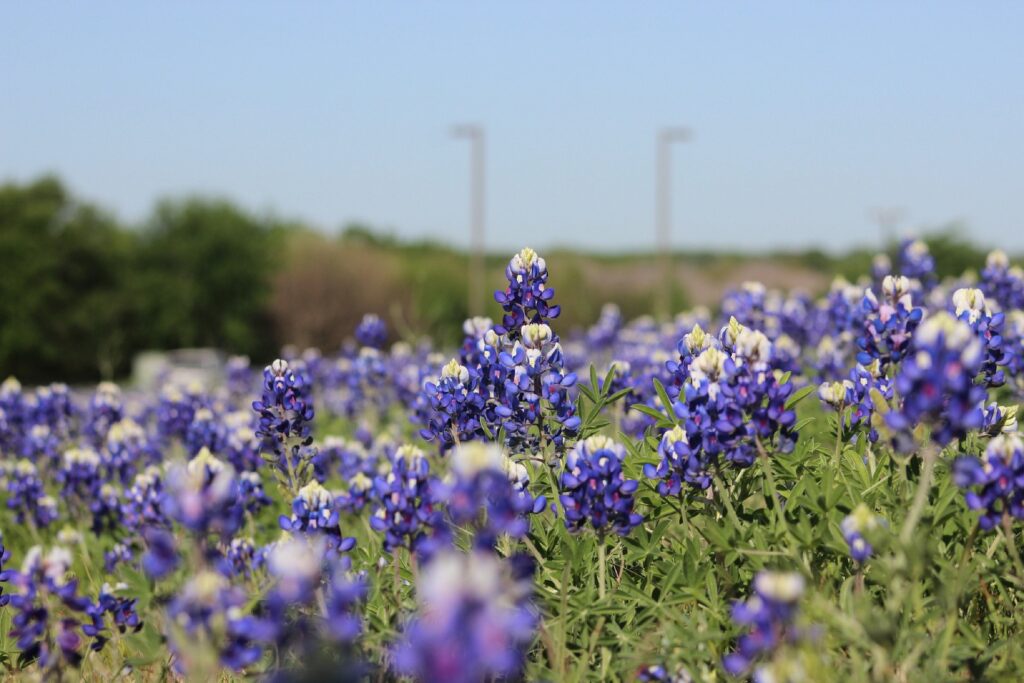
Texas Bluebonnets typically bloom in early spring, from March to May, depending on local climate conditions. After flowering, the plants begin to fade, but they often continue to grow and produce seed pods, which mature over the summer. These plants are generally biennial, meaning they complete their life cycle over two years.
However, once they set seed, Bluebonnets can reseed naturally, ensuring that they may reappear the following year without the need for replanting. They tend to self-sow, so if the conditions are favorable, you might see new plants growing in the same spot year after year.
During the winter months, Texas Bluebonnets die back, as they are not frost-tolerant.
Collecting Texas Bluebonnet Seeds for Planting
Harvesting and collecting seeds from your Texas Bluebonnets is a straightforward process, and it’s an excellent way to ensure that you can grow more plants for the following year.
Allow the seed pods to ripen fully on the plant. This typically happens in late spring to early summer. The pods will start off green and gradually turn brown as they mature.
It’s important to wait until the pods are fully dry before harvesting, as immature pods will not contain fully developed seeds.
Once the pods are dry and brown, carefully cut them from the plant with a pair of scissors or garden shears. Be sure to handle the pods gently to avoid damaging them, as they can crack open and spill the seeds.
Once you have harvested the pods, place them in a container or a paper bag. Let the pods dry for a few days in a cool, dry location.
After they have dried fully, gently break open the pods by hand or by lightly tapping them, allowing the seeds to fall out.
Store them in a cool, dry place until you are ready to plant them. Keep the seeds in an airtight container, such as a glass jar.
Tips for Saving Bluebonnet Seeds
Collect seeds in dry weather to prevent the pods from becoming moldy.
Harvest a variety of pods from different plants to ensure genetic diversity in your next planting.
Avoid storing seeds in areas with high humidity, as moisture can cause them to spoil or mold.
Bring the Beauty of Texas Bluebonnets to Your Garden
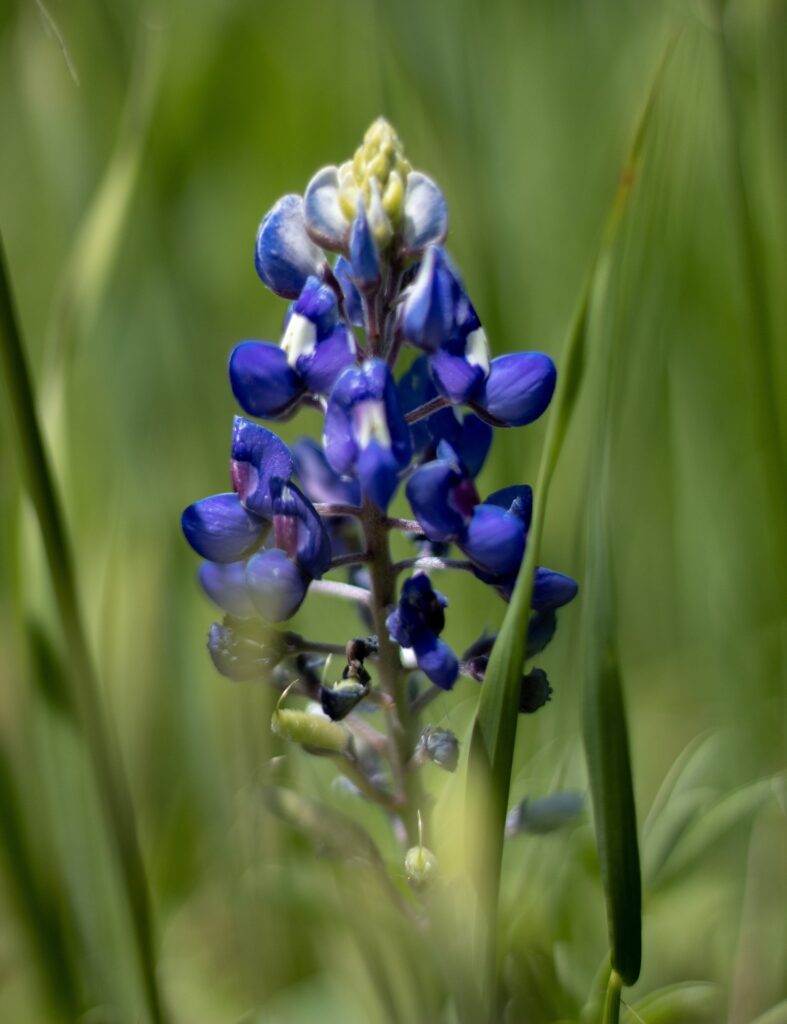
Texas Bluebonnets are a striking addition to any garden, with their vibrant blue flowers adding color and charm to landscapes.
Whether you’re planting them for their beauty, to support local wildlife, or to create a stunning native wildflower patch, growing Texas Bluebonnets is a rewarding experience.
With the right care, timing, and seed collection, you can enjoy these beloved flowers season after season.
Texas Bluebonnets’ adaptability to different growing zones, low maintenance, and ecological benefits make them a must-have for any garden.
Last update on 2025-07-16 / Affiliate links / Images from Amazon Product Advertising API
This product presentation was made with AAWP plugin.









